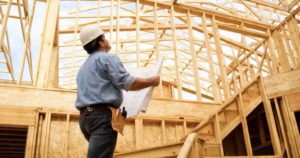 The builder business, a major driver of the U.S. economy, is entering uncharted waters in 2023. For the first time in 11 years, single-family home construction is coming off a year of slower activity. Surging lending rates and building materials costs, plus deteriorating affordability conditions continue to put a damper on housing production.
The builder business, a major driver of the U.S. economy, is entering uncharted waters in 2023. For the first time in 11 years, single-family home construction is coming off a year of slower activity. Surging lending rates and building materials costs, plus deteriorating affordability conditions continue to put a damper on housing production.
“The single-family market performed well in 2022 vs. projections, albeit the first half of the year was much better than where we stand today,” observed Doug Kenney, vice president of sales of builder + multi-family, Shaw. “Rising interest rates and overall product inflation have dramatically slowed the single-family market during the back half of 2022.”
Builders witnessed the first signs of a downturn in early 2022 as housing prices increased dramatically, in part from historically high costs for lumber and other essential building materials. By November, new single-family housing showed signs of softening. After two consecutive years of 14% growth, single-family construction fell roughly 12% to 949 million units, noted Sarah Martin, senior economist, Dodge Construction Network.
Meanwhile, housing permits and starts continued declining due to high mortgage rates, ongoing building material production disruptions and flagging demand stemming from rising housing affordability. “Given expectations for ongoing elevated interest rates due to actions by the Federal Reserve, 2023 is expected to see additional single-family building declines as the housing contraction continues,” said Robert Dietz, chief economist at the National Association of Home Builders (NAHB).
The latest new residential construction data paints a cloudy picture for short-term growth prospects heading into the new year. Overall housing starts decreased 4.2% to a seasonally adjusted annual rate of 1.43 million units in November, according to a report from the U.S. Department of Housing and Urban Development and the U.S. Census Bureau. Within this overall number, single-family starts decreased 6.1% to an 855,000 seasonally adjusted annual rate. The multi-family sector, which includes apartment buildings and condos, declined 1.2% to an annualized 570,000 pace during the period.
The housing market downturn has not gone unnoticed by flooring suppliers, as the segment represents approximately one-third of industry sales. “In 2023, we expect to see a slowdown in single family,” said Brian Dolfi, senior vice president, builder + multi-family, Mohawk. “With interest rates being higher and the Fed signaling more increases, it will slow down new home buyers.”
The snail pace of the housing market’s growth is amplified by the number of privately owned units authorized by building permits. As of November 2022—the most recent period for which reliable numbers are available—this figure declined 2.4% from the previous month and 10.1% below the same period a year ago to a seasonally adjusted annual rate of 1,526,000, the Census Bureau reported. The lion’s share of building permits comes from single-family authorizations, which dipped 3.6% behind the revised October figure of 870,000 while buildings with five or more units dropped 2% to a rate of 633,000.
But the news is not all bad from the home front. “Even as single-family starts recede, however, this sector is still poised to have its third best year since the Great Recession,” Dodge’s Martin pointed out.
Meanwhile, the 296,000 privately-owned housing units authorized but not yet started is up 1% over the seasonally adjusted annual rate in October and 10% above November 2021, the Census Bureau reported. This is a stark reminder, however, how supply chain bottlenecks slow down new home construction projects nationwide.
Macro issues suppress growth
Moving into the first half of 2023, the slowing economy is expected to weigh on the housing market, observers agree. “High inflation is projected to constrain consumer budgets, alongside rising rents, home prices and surging mortgage rates, while wages will remain well below the pace of inflation,” Dodge’s Martin said.
In an effort to fight persistent inflation, the Federal Reserve continues to tighten monetary policy and raise interest rates. However, this could do more harm than good if it goes to far. “This will cause some economic pain, including a weaker economy and job losses,” NAHB’s Dietz explained. “We expect a mild recession in 2023 given tightening financial conditions and increased economic uncertainty.”
A case in point is escalating home costs, which are reportedly pricing entry-level and first-time home buyers out of the market. In November, home mortgage applications were down 41% from a year ago, NAHB statistics show. The purchasing power of new home buyers is further compromised by rising interest rates, as a 30-year fixed-rate mortgage hovers around 7% today—approximately twice what it was at the beginning of 2022. “With more limited purchasing power, home buyers and renters could pull back and housing construction will decelerate from the record highs seen over the last two years,” Dodge’s Martin said.
The most recent NAHB Housing Trends Report showed interest in new homes jumped 19% in the first quarter of 2022 to 27% in the third quarter. But the marginal increase suggests the prospect of higher mortgage rates in the near term will lead a small segment of consumers to consider purchasing a home sooner than later. “As buyers react to lower affordability conditions, we expect some to respond with seeking smaller homes,” Dietz explained. “This will, unfortunately, have a contractionary impact on some material markets.”
These and other economic indicators pointing in the wrong direction are concerning to new home developers. Builder confidence in the market for newly built single-family homes posted its 11th straight monthly decline in November, according to the NAHB/Wells Fargo Housing Market Index. This represents the lowest confidence reading since June 2012—with the exception of the onset of the COVID-19 pandemic in the spring of 2020. “Higher interest rates have significantly weakened demand for new homes as buyer traffic is becoming increasingly scarce,” NAHB chairman, Jerry Konter, a home builder and developer from Savannah, Ga., stated in a release. “With the housing sector in a recession, the Biden administration and new Congress must turn their focus to policies that lower the cost of building and allow the nation’s home builders to expand housing production.”
The road ahead
Flooring industry members are keeping a close eye on business conditions that stand to impact soft and hard surface sales to new home buyers. “We understand that the average cost of homes and average rent across the market are high,” stated Dan Butterfield, vice president of residential sales, Daltile. “Consumers will expect more than base-grade product categories installed in these dwellings.”
Housing affordability is one of the biggest issues facing builders in the new year and has a trickle-down effect for providers of interior decorating products such as flooring. “I could see houses shrink to hit better price points as we move through 2023 and product de-mixing to more affordable flooring,” Mohawk’s Dolfi noted.
Shaw’s Kenney concurred, adding: “Our customers are already scaling down square footage of existing plans, adopting new floor plans to better utilize smaller lots and building denser communities.”
Further compounding matters is the ongoing skilled labor shortage, which is contributing to construction delays and higher home building costs. “Attracting skilled labor will remain a key objective for construction firms in the coming years,” NAHB’s Dietz said. “However, while a slowing housing market will take some pressure off tight labor markets, the long-term labor challenge will persist beyond an ongoing macro slowdown.”
On the supply side, rising building materials costs and supply chain issues will contribute to the deceleration in residential construction, industry watchers say, as builders continue catching up to housing demand. But despite these and other macro issues stunting growth, the tide is expected to turn later in the year. “Modest growth should return in the latter half of 2023,” Dodge’s Martin predicted. “Where supportive demographics and continued shortages in the housing supply will support residential growth in the longer term.”

